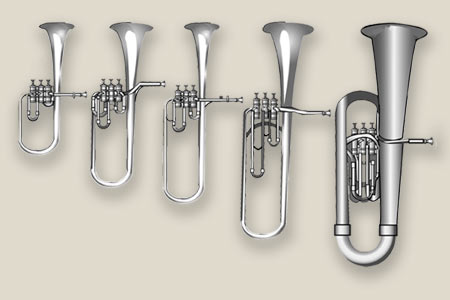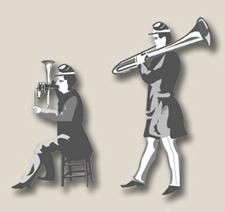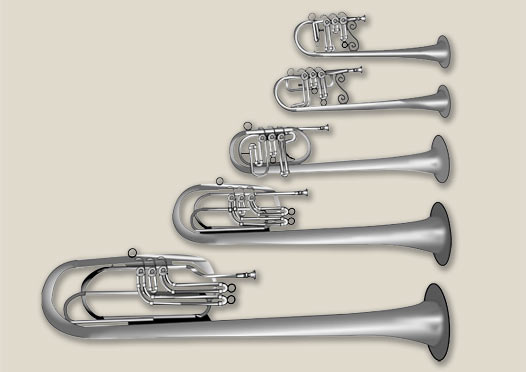Adolphe Sax and the Saxhorn in the Civil War
Read More Articles:
Adolphe Sax, his Saxhorn and the People Who Made It Popular During The War Between The States
Written and Illustrated by Eric Ortner
(Originally Published in the Civil War Courier)

Some of the most important social activities in the mid 19th Century were performances from community music ensembles. Around the time of the American Civil War the ensembles were more often than not brass bands. The great popularity of the brass band was a result of many individual's contributions to the improvement of brass instruments.
There have been thousands of instrument manufactures through the ages. Yet in the minds of most people today, there are really only two names associated with the title instrument maker. The first is obvious, Stradivarius. The second is equally well known, but seldom thought of; Adolphe Sax. Sax was the inventor of the saxophone and more importantly for those interested in the history of the Civil War, the Saxhorn.
Adolphe Sax was born in Brussles on November 6, 1814. His father, Charles Sax, was a joiner and cabinetmaker. Charles eventually worked in a factory and later began to produce woodwind instruments like serpents and flutes. Charles was self-trained, and his work became so well regarded that King William I appointed him Instrument Maker to the Court of the Netherlands. This required Charles to supply the Belgian military bands with instruments. What Charles Sax learned in the creation of his acclaimed instruments was, that variations in tones were created by the proportions of an instrument's bore. The sound further depended on whether the instrument was cylindrical, conical or a combination of both. He also noticed the importance of the method by which the source of the sound was created. He closely studied the oboe's double reed, the clarinet's single reed, the trumpet's cup mouthpiece and the flute's open hole. Charles Sax was one of the first people to conduct thorough research in this field. Charles' eldest son, Adolphe, was there to assist him with all of his work, and in the process, Adolphe learned a great deal.
There is not a whole lot written about Adolphe's mother. She bore 11 children, few of whom survived into adulthood. The only quote that she is known to have said is, "The child is doomed to suffer; he won't live."
She said this of Adolphe after he nearly drowned in a river. He had numerous other mishaps that consisted of several poisonings, a serious fall down stairs, a close call with a gunpowder explosion, which badly burned him, a hot frying pan falling on him along with a roof stone hitting him in the head leaving a scar that remained long into adulthood. This sort of bad luck can almost be seen as an omen of the sort of life that lay ahead for young Adolphe.
Adolphe's misfortunes did not hinder him in becoming a skilled instrument manufacturer though. Before he was even in his teens, Adolphe Sax had learned how to drill the pieces of a clarinet to perfection. He was even able to create the involved key work of these instruments. At the age of 14 Adolphe began to study music at the Royal School of Singing. He started studying flute, but later took up the clarinet under the instruction of Valentine Vender, who was a famous Belgian bandmaster. He learned quickly from Vender, and in 1834 Joseph Küffner, a German bandmaster and composer dedicated a work for two clarinets to Adolphe.
Although Adolphe Sax gradually drifted back to producing instruments in his father's shop, what led to his career as an instrument maker was his vast improvements to the bass clarinet which were made public in June of 1838. After a successful trip to Paris with the instrument, Adolphe returned to Brussels where he met great disappointment in the Brussels Exhibition of 1841. Sax was encouraged by Jacques Halévy, whom he had met in his trip to Paris, to return there and continue to create his family of instruments. Against his father's objections, Adolphe left Brussels for Paris with only 30 Francs to his name.
Sax's arrival in Paris bordered on disaster. His father had warned him when he left that the French manufacturers did not take kindly to foreign competition on their own soil. He was loaned 4,000 francs by Halévy and other friends. Sax then set up a shop on Rue St. Georges and began to advertise his instruments. When a local conductor tried to write parts for them, the orchestra members refused to use them because they were not French. Shortly after, almost all of the loaned 4,000 francs were stolen. It is believed that the offender was most likely one of Sax's competitors.

There was a call for support from King Leopold of Belgium to sponsor the work of Sax. Initially the King was uninterested, but General Rumigny was able to convince him that Sax's instruments were optimal for military style music. As a result of the King's new-found interest, stock in the company was made available on the Paris Stock Exchange. Sax's rivals bought out all of the stock and sold it for half the price. His competition once again succeeded in ruining his business.
Adolphe Sax had many powerful connections, though, and as a result his competitors were never completely able to keep him down. As a third chance to rebound from his economic woes, a concert was arranged. It was a competition between bands using traditional instrumentation and instruments produced by Sax. The commission and huge audience that was in attendance supported Sax. He believed that his financial problems would finally be over, but this was not the case. Adolphe's competitor's bribed his employees to get the plans for his instruments and then promptly sued him saying that Sax had stolen their instruments. As a result, Sax sold the factory for four thousand Francs.
He traveled to England promoting his saxophones with limited success in small concerts. He then returned to France in the fall of 1845 and bought back his factory. The French government, which was convinced of the Sax instruments superior quality due to the contest, ordered hundreds of instruments for the official military bands. Upon General Rumigny's suggestion, prison labor was used to produce these instruments. This was only because Sax could still not afford to pay skilled employees.
This new success was still very short lived. In 1848 the French government was in upheaval due to revolution. The turmoil which ensued lead to the revocation of Sax's military contract. His banker went bankrupt as a result of Sax's inability to pay his loan. Adolphe was thus thrown into debtor's prison. He was released shortly after because of his friend's support.
When President Louis Napoleon appointed himself Emperor Napoleon III, opportunity once again arose for Sax, and once again Sax's powerful military connections saved the day. The Emperor's Aide-de-camp Colonel Fleury, was a friend of Adolphe, and introduced him to the Emperor. With strong urging on Fleury's part, Napoleon III agreed to give Sax payment of 20,000 Francs per month to build the instruments for military bands. Unfortunately for Sax, this arrangement did not last long. He lost a similar opportunity in 1859 when the French government replaced all of their military instruments.
In the area of brass instruments it is difficult to call Sax an inventor. It would be much more accurate to call him a perfectionist. Adolphe Sax's principals were gained primarily from the work of his father. Sax was interested in the study of acoustics. He was concerned with correct proportions such as measurements of bore size, tube length, valve placement, and mouthpiece construction. He realized that by paying close attention to such details, the discrepancies in intonation between instruments could be eliminated. What his efforts resulted in, were the creation of homogenous families of instruments.
Prior to the work of Sax, military brass instruments came from many manufacturers in a wide variety of shapes. These deviations resulted in a discrepancy of tuning. These problems were further amplified due to the fact that many bands had both keyed and valved brass instruments intermixed.
The complete family of brass instruments, although vastly improved was not even Sax's invention. Previously, a French manufacturer, Danays, created a family of valved bugles called Clavicors. What made Sax's work significant was the overall quality of his instruments. By 1849, Adolphe Sax had unveiled three of his greatest contributions to the brass world. Sax adopted an upright tuba shape for all of these instruments. Originally, even the highest pitched instruments in his family of five were positioned upright. However, his quest for acoustic perfection later caused Sax to use horizontal patterns that resemble the modern cornet.
All the Sax families utilized the same bore size regardless of whether they were conical or cylindrical. The saxhorn was a conical family, which used the same fingerings for notes, and the same basic mouthpiece shape for all its members.

Sax took existing ideas in valve design, and improved them. He borrowed some of his valve designs heavily from the instrument maker Moriz in Berlin. Adolphe became skilled at making Moritz's Berliner-Pumpen valve, and even was able to make an improvement to it. He did so by smoothing out the nine sharp angles that were integral to the valve system. These sharp bends in the wind passage of brass instruments were often the cause of poor tone. He did some similar work with rotary valves.
Adolph's efforts in the creation of a valved instrument with great tone resulted in the creation of the saxhorn. The Saxhorn family was patented in October of 1845 and utilized a wide coned, deep cupped mouthpiece which resembles a modern French Horn's. There were numerous lawsuits filed against Adolphe by his competition in regards to this popular instrument. However, none of the cases were successful.
Saxhorns had a larger bore than that of a trumpet. The bore's conical shape produced a mellow tone. This warm sound was preferred by the nineteenth century audience, both in the United States and in Europe over the bright tone of a cylindrical trumpet. These preferences most likely resulted from the lack of mellow sounding woodwinds in an all brass band. The bright tone of an ensemble made up entirely of cylindrical brasses would have been very overwhelming.
The complete saxhorn family, was designed to perform in military as well as orchestral functions. The instruments intended for military use were tuned in E-flat and B-flat, while instruments designed for use in the orchestra were in the keys of C and F. The complete set of Saxhorns consists of seven members. The soprano in E-flat and the soprano in B-flat were identical in pitch to the standard cornet. The alto member of the family was tuned in E-flat, while the baritone was in B-flat. The bass was built in the key of B-flat. The bass also had a big brother tuned to BB-flat. Sax completed the family a couple years after he unveiled the original 5 instruments with a tuba in E-flat. The differences in baritone and B-flat bass Saxhorns are subtle. The bass members of the family have larger bores and as a result are able to produce fuller low notes with less effort.
Saxhorns gained more favorable attention from military bands than they did in orchestras. This is partially because they blended too well with string instruments and the desired contrast in tonal quality between the two families is absent. This reason was in addition to orchestra member's dislike for the instruments. Their distaste was not simply due to Sax's nationality, but also because the orchestra members would be forced to purchase and learn how to perform on new instruments. However, a few composers did find a place for the saxhorn in their arrangements.
Even with great critical acclaim and powerful connections in France and abroad during his life, Sax died on February 4, 1894 a penniless man. He was forced to sell off his valuable collection of 467 instruments in 1877 to repay his debts. His debts were of course a direct result of poor business skills. This weakness caused Sax to fall victim to the greed of his unscrupulous competitors. So with all of Sax's misfortunes, how was he able to earn a name on instruments in the United States? This question is easily answered with another family name.
The Distin family were an English quintet. The leader, and father, John Distin was a member of King George IV's Household Band. At this point, John was playing slide-trumpet on which he was considered to be the second best performer in Great Brittain. He was the first trumpet in the orchestra that triumphed the coronation of Queen Victoria.
John's children were encouraged to take after their father. The Distin family toured Great Britain as a miniature brass band, and were immensely popular with all who had heard them. With their success, the family decided to try their luck on the rest of the continent. It was on this tour that they made the acquaintance of Adolphe Sax.
The Distin family did not achieve the same critical acceptance in the rest of Europe that they had previously been used to in England. This was especially true in Vienne. There they performed terribly in an audition. Their shoddy execution was a direct result of their crude instruments. On February 4, 1844 they met Sax at the Rue-Saint-Georges workshop after hearing the saxhorn for the first time the night before.
Sax was eager to present the Distin's with his creations, according to Henry Distin's recollections. Success for the Distins followed with the receipt of their new instruments. Although the new found friendship between Sax and the Distins was mutually beneficial, it almost certainly did more for the promotion of Sax's instruments. The instruments were taken back to England where they earned a great deal more notoriety. In 1846 the family took saxhorns across the Atlantic Ocean to the United States of America where many heard the instrument for the first time.
It is believed that the first band to purchase saxhorns in the United States was the Stonewall Brigade Band of Staunton, Virginia. In fact before they joined the 5th Virginia Infantry, the performers called themselves the Mountain Saxhorn Band of Staunton. They carried these instruments throughout the Civil War. They were by no means the only southern band to do so.
The 26th Regimental Band from Salem, North Carolina also carried them. Brass instruments were far superior to their woodwind counterparts in the conditions of war. That is, of course, one of the reasons that brass bands gained popularity during the Civil War. However, brass instruments could also fall prey to the trials of military life. The Salem band's instruments were no exception. In April of 1864 the band members requested that Governor Vance attempt to run the blockade and trade cotton for a new set of Saxhorns. The governor's aide responded by saying, "He (Vance) directs me to say he will ship the cotton for that purpose if you will furnish it, provided the steamers continue to run."
That was an unfeasible proposition for almost any Confederate soldier in that late month of the war. To add insult to injury, the 26th Regimental Band was forced to give most of their battered instruments up to Union Troops in the last days of the war, when they were captured by the Yankee army. Julius Augustus Leinbach wrote of his capture, "We walked up to them and were taken in charge. Our instruments were taken from us and that seemed to be the bitterest experience of all…"
Some of the Instruments played by various North Carolina Bands, including an E flat bass over the shoulder saxhorn played by Leinbach in the early part of the war, can be seen publicly. These are in the Wachovia Museum of Old Salem. There are other strong collections of Civil War period instruments on public display throughout the country. The Smithsonian and the Henry Ford Museum both have extensive displays. However, there are no public exhibits of a complete set of 7 saxhorns in the United States.

True upright saxhorns were not widely used by Union and Confederate troops during the war. Instead, they preferred the over the shoulder instruments patented in 1838 by Allen Dodworth and manufactured in Austria. The name Saxhorn is more often than not used to describe over the shoulder instruments as well as the upright style. This is an inaccurate title. However, it is an inaccuracy, which was not started anytime recently. The nomenclature was even used in the wrong context during the time of the War Between the States. However, for the interest of this article, the over the shoulder instruments will be discussed as well.
It is important to note that for the most part, over the shoulder instruments were also made in matching families. Therefore, they at least held true to the principals of Sax. Over the shoulder instruments were made of the same length of tubing. However they had tighter coils which created a longer neck than upright instruments. Therefore they appear longer. Another big difference between the two instruments was that over the shoulder versions utilized rotary valves for the most part, as apposed to the Berliner-Pumpen Valves preferred by Adolphe Sax. (See Coronet Article For Complete Description)

Allen Dodworth was a strong supporter of Sax's creation. In 1849 he described them as being, far superior to any other class of instruments in use. Allen Dodworth designed over the shoulder instruments specifically for marching. He wrote a very influential instruction book called, Dodworth's Brass Band School, published in 1853. It helped to inform small community bands how to start and maintain a successful organization. It is important to note that most of the bands that enlisted in the Civil War were originally amateur community bands that performed with local militias. In Dodworth's Brass Band School, he suggested, "In selecting the instruments, attention should be paid to the use intended; if for military purposes only, those with bells behind, over the shoulder, are preferable, as they throw all the tone to those who are marching to it, but for any other purpose are not so good ….For general purposes, those with the bell upward, like the Sax Horn, are most convenient, and should be adopted by all whose business is not exclusively military; care should be taken to have all the bells one way."
Many amateur bands of the day used instrumentation combining over the shoulder instruments, up right saxhorns and bell front instruments. This mixture caused significant problems with intonation. This sort of instrumentation was often partially the result of the cost of instruments, or in many cases simply an ignorance of acoustic science.
Allen Dodworth was very influential as a band leader and as an instrument inventor. One of his most widely known protégés was Patrick Gilmore, the famed cornet player of the Boston Brigade Band. Like Gilmore's ensemble, The Dodworth Band participated in the Civil War. At this point in time it was lead by Allen's Brother Harvey.
Harvey Dodworth took over the directorship of the band in 1860. In 1862 Harvey was selected by the war department to serve on an advisory board to suggest a policy for military bands. Naturally, Dodworth's selection for instrumentation of regimental bands included over-the-shoulder saxhorns.
The band enlisted for three months as part of the 71st New York Militia Regiment. The band was not just an excellent relief from the drudgery of military service. They earned their pay at the First Manassas by serving and rescuing the wounded on the battlefield. Although enlisted for only a short period, the Dodworth Band later aided the Union's war effort by performing benefit concerts.
The disparity between the two armies is also evident in regards to their bands. While the 71st was gallivanting around in New York's high society, the 26th Regimental Band from Salem, North Carolina had its own version of benefit concerts. These were solely performed in the interest of putting food in their own stomachs.
Over the shoulder instruments were by no means exclusively made in Europe. This increasingly became the case after 1850. There were many manufacturers in the United States who were quite successful as a direct result of the War Between the States. Some of the manufacturers set up shop in the Boston area. Graves and Company, J. Lanthrop Allen, E.G. Wright were just a few Boston area manufacturers.
There were other instrument makers who constructed Sax style instruments in New York City. C.A. Zoebisch and Sons were one such manufacturer. Harvey Dodworth from New York also has his name imprinted on some over the shoulder instruments. These were not actually manufactured by the Dodworth family, but by John F. Stratton another New York City instrument maker. Harvey's endorsement was as much required to save the family name, as it was to earn a little extra money. Instrument manufacturers at the time were claiming to produce instruments endorsed by the Dodworths. Many of these endorsed instruments were of poor construction. Therefore, the H.B. Dodworth seal on John F. Stratton's instruments had a great deal of meaning when it came to quality.
Stratton was also one of the first manufacturers to mass produce instruments. His first factory in New York was established in 1860. In 1861 Stratton was filling government contracts and producing an unprecedented 100 instruments a day. These were for the most part field trumpets and bugles though, not saxhorns. Still his contributions in the area of mass production made sets of instruments readily available at reasonable cost by the end of the war.
One manufacturer who learned a great deal from Stratton's efforts was Henry Distin. Henry, who was a famed member of the Distin family, worked for a brief time in Philadelphia with the J. W. Pepper Company in 1877. After working with them he set up his own factory in Williamsport, Pennsylvania in 1887.
Although over the shoulder saxhorns were very popular during the Civil War, they began to fall out of favor by 1870. The 24 member brass marching band lost its popularity as grand concert bands with mixed winds received the most critical acclaim. With the exception of the baritone, saxhorns are no longer used in most American bands. However, to this day in England, community brass bands still use the saxhorn family. Musical tastes change though. Today in the United States it is painful to watch the attendance of concerts put on by community bands in local parks dwindle in some areas. As fewer and fewer people show up to these community performances, one of the last vestiges of 19th century social life becomes another memory.
Bibliography
The Instruments of Adolphe Sax, Gerald Loren Welker
A Johny Reb Band From Salem The Pride of Tarheela, Barry H. Hall
Adolphe Sax 1814-1898, Wally Harwood
Arms and Equipment of the Confederacy, Editors of Time Life Books
Music And Musket, Kenneth Olson
A Pictorial History of Civil War Era Musical Instruments & Military Bands, Mark Elrod Robert Garofalo
Bands of the Confederacy, Benny Pryor Ferguson
Bands and Drummer Boys of the Civil War, Francis A. Lord and Arthur Wise
Early American Brass Makers, Robert E. Eliason
The Music Men, By Margaret Hindle Hazen and Robert M. Hazen
American Musical Instruments, Laurence Libin
The Cambridge Companion to Brass Instruments, Trevor Herbert and John Wallace
A History of Military Music in America, William Carter White
Bands of America, H.W. Schwartz
Brass Instruments Their History and Development, Anthoney Baines
The Keyed Bugel, Ralph T. Dedgeon
Military Music, Henry George Farmer
The Trumpet, Edward Tarr
The Trumpet and Trombone, Philip Bate
French Horn, Robin Gregory
